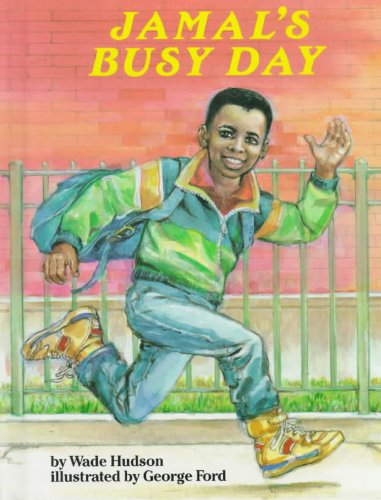-
Book Of Black Heroes: Scientists, Healers & Inventors
Mr. Wade Hudson
Paperback (Just Us Books, Incorporated, July 5, 2013)In this volume of the popular Book of Black Heroes series, readers will learn about the many contributions Black men and women have made in the areas of science, medicine and creative invention. Short entry biological sketches herald the ground breaking work of well-known Black heroes such as scientist, George Washington Carver and surgeon, Dr. Daniel Hale Williams, and introduce the trailblazing accomplishments of other Black heroes such as inventor Lewis Latimer and Halle Johnson. Z
Z
-
Jamal's Busy Day
Wade Hudson
Paperback (Just Us Books, Dec. 1, 1991)Jamal, a handsome, energetic African-American boy, is shown making all the necessary preparations for school that his parents make to begin their day. The upbeat message is that both parents and child can work hard and accomplish much in their respective areas, all have something to contribute. J
J
-
Anthony's Big Surprise
Wade Hudson
Paperback (Just Us Books, Oct. 1, 1998)Someone is sending Anthony expensive gifts. When Anthony figures out who it is, he discovers that his entire world is about to change. This is the third book in NEATE, a popular middle reader series featuring 5 African-American pre-teens. N
N
-
The Underground Railroad
Wade Hudson
Library Binding (Childrens Pr, March 1, 2005)Describes how a network of people, organizations, and places helped slaves escape, and includes stories of people who used the Underground Railroad to escape. S
S
-
Book of Black Heroes: Scientists, Healers, and Inventors
Wade Hudson
Library Binding (Paw Prints, Aug. 11, 2008)SET of six (6) highly-sought-after NonFiction Picture Book titles (African American) – a great collection for a parent's home library, or classroom bookset for Educators! DID YOU KNOW these books can support instruction for UNDERSTANDING NonFiction & ANALYZING NonFiction text. Yes, many successful Public Schools districts, administrators, coordinators, teachers, librarians, and ELA support staff suggest NonFiction picture books be used to effectively teach ELA skills & strategies, Grade K-12 – it's simply a matter of scaffolding from simple through more complex mentor exemplar texts. Each of the six (6) NonFiction picture books in this offer are referenced in Guiding Readers and Writers, by Fontas and Pinnell (not included), and support instruction: to teach sustained reading comprehension skills & strategies; theme, main idea, supporting ideas, supporting details, fact and opinion, cause and effect, compare and contrast, & organizational structure. Offer for one (1) NONFICTION
-
Five Notable Inventors, Great Black Heroes
Wade Hudson
Paperback (Scholastic, Aug. 16, 1995)Great Black Heroes Five Notable Inventors Wade Hudson 1995 Paperback Illustrated. Great Black Heroes. Five Notable Inventors. Hello Reader! Series. Madame C.J. Walker/Elijah McCoy/Garrett A. Morgan/Granville T. Woods/Jan Ernst Matzeliger. By: Wade Hudson. Illustrated By: Ron Garnett. Copyright: 1995. ISBN 0-590-06678-1. Illustrated. First Scholastic Inc. Edition. PUBLISHER: Scholastic Inc., New York. Paperback. Printed In The United States. Condition: OVERALL GOOD CONDITION. PREVIOUS SCHOOL BOOK. FULLY BOUNDED. SEE PHOTOS FOR FULL DESCRIPTION AND IMAGES OF ITEM.
-
Nature in Downland
W.H Hudson
eBookNature in Downland. 404 Pages.
-
The Purple Land
W. H. Hudson
Paperback (CreateSpace Independent Publishing Platform, April 24, 2017)The novel tells the story of Richard Lamb, a young Englishman who marries a teenage Argentinian girl, Paquita, without asking her father's permission, and is forced to flee to Montevideo, Uruguay with his bride. Lamb leaves his young wife with a relative while he sets off for eastern Uruguay to find work for himself. He soon becomes embroiled in adventures with the Uruguayan gauchos and romances with local women. Lamb unknowingly helps a rebel guerrilla general, Santa Coloma, escape from prison and joins his cause. However, the rebels are defeated in battle and Lamb has to flee in disguise. He helps Demetria, the daughter of an old rebel leader, escape from her persecutors and returns to Montevideo. Lamb, Paquita, Demetria and Santa Coloma evade their government pursuers by slipping away on a boat bound for Buenos Aires. Here the novel ends, but in the opening paragraphs, Lamb had already informed the reader that after the events of the story he was captured by Paquita's father and thrown into prison for three years, during which time Paquita herself died of grief. Ernest Hemingway famously referred to Hudson's book in his novel The Sun Also Rises: Then there was another thing. He had been reading W.H. Hudson. That sounds like an innocent occupation, but Cohn had read and reread The Purple Land. The Purple Land is a very sinister book if read too late in life. It recounts splendid imaginary amorous adventures of a perfect English gentleman in an intensely romantic land, the scenery of which is very well described. For a man to take it at thirty-four as a guide-book to what life holds is about as safe as it would be for a man of the same age to enter Wall Street direct from a French convent, equipped with a complete set of the more practical Alger books.
-
Jamal's Busy Day
Wade Hudson
Paperback (Just Us Books, Oct. 1, 1991)Readers follow events in a youngster's day from the child's own perspective. J
J
-
God Gave Me Board Book
Wade Hudson
Board book (Abingdon Press, Jan. 1, 2004)Children naturally enjoy the wonders of God's creation. In this simple book, a child shares what God has given him, from parents who love him to the joy of getting his first bike. Features engaging full-color illustrations. (Board Book) D
D
-
God Smiles When
Wade Hudson
Board book (Abingdon Press, Jan. 1, 2003)This gentle, reassuring story told in rhyme tells the story of a young African American child who goes through the day discovering many ways that God is near at all times. N
N
-
AFRO-BETS Book of Black Heroes From A to Z: An Introduction to Important Black Achievers: Volume 1 by Wade Hudson
Wade Hudson;
Paperback (Just Us Books, Incorporated, March 15, 1800)None